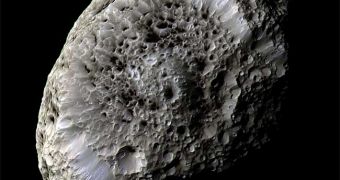Hyperion, a satellite of Saturn, is one of the strangest moons in our solar system, whose behavior and composition has puzzled astronomers for many years. This moon really looks like a giant cosmic sponge, but there are many more weird properties that have just recently been explained.
A highly irregular body in the solar system, it doesn't even resemble a sphere and is marked by a huge crater on the surface, approximately 120 km in diameter and 10 km deep. Scientists have theorized that this is actually a fragment of a larger celestial body that was broken by a large impact in the distant past.
The sponge-like aspect is due to the numerous impact craters on its surface, which, observed at a distance, look like tiny pores on a sea sponge. The new discovery, made after analyzing data obtained by NASA's Cassini spacecraft during its flybys of Hyperion in 2005 and 2006, finally solved the mystery of its aspect.
The reason why it was called the giant sponge in space is the fact that it's actually made of a highly porous material which favors the formation and preservation of hundreds of craters, ranging from 1 to 6 miles (2 to 10 km) in diameter.
This makes the celestial body act very different than our Moon for instance. On the Moon, an impact would produce, besides the crater, a giant spray of rock and dust that would rain back on the surface, partially filling the crater and the ones around it. On Hyperion, the surface, being so brittle, doesn't send out any kind of material, which keeps the surrounding crater at their initial depth.
"Theoretical work suggests that if you have a porous target, craters may be more compressional instead of being explosive and tossing stuff out," said Peter Thomas of Cornell University, author of one of the studies.
Another strange characteristic of the satellite could explain its behavior, as new observations confirm that Hyperion is made mostly of water ice, with very little rock. "We find that water ice is the main constituent of the surface, but it's dirty water ice," said Dale Cruickshank, a researcher at NASA Ames Research Center who led the second study. "Fresh water ice would look very bright in reflected sunlight, but this is definitely dingy."
What the studies weren't able to solve is the problem of the chaotic rotation of Saturn's satellite. Unlike our Moon, which is tidally locked, meaning that it will always show the same face, Hyperion is not, thus undergoing this strange, chaotic rotation, making its axis of rotation shift to such an extent, that scientists can never reliably predict its orientation in space.

 14 DAY TRIAL //
14 DAY TRIAL //